The demand for frozen egg in Japan is expected to grow from USD 206.1 million in 2025 to USD 308.8 million by 2035, reflecting a CAGR of 4.1%. Frozen eggs are widely used in the food industry, including in baking, ready-to-eat meals, and confectionery products, due to their convenience, extended shelf life, and cost-effectiveness. Demand for frozen egg in Japan is driven by increasing demand from food manufacturers and the growing adoption of frozen food products in both retail and foodservice sectors. The demand for frozen eggs also benefits from Japan's growing focus on sustainability and food waste reduction, as they offer a longer shelf life than fresh eggs, reducing the need for frequent restocking.
As consumers become more conscious of food waste and efficiency, frozen eggs are positioned as a viable alternative for manufacturers looking to optimize storage and transportation costs. The growing trend toward ready-to-eat meals, food convenience, and frozen bakery items in Japan is expected to support further the market's steady growth over the next decade.
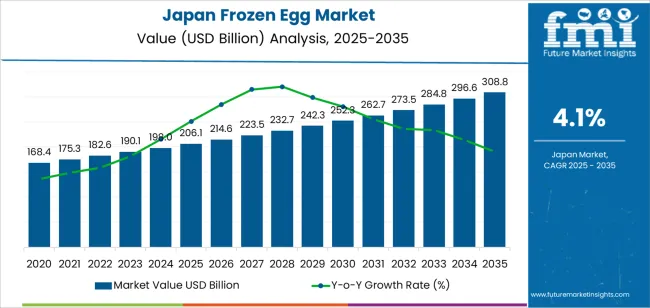
The peak-to-trough analysis for frozen eggs in Japan reveals the key shifts in the demand trajectory over the 2025 to 2035 forecast period. From 2025 to 2030, the demand will grow from USD 206.1 million to USD 252.3 million, reflecting an increase of USD 46.2 million. This early phase will experience a steady upward trajectory, driven by the increasing adoption of frozen egg solutions in food production, baking, and ready-to-eat meals. As the market continues to mature, the peak demand will likely occur around 2030, when the adoption of frozen egg products reaches its highest level due to expanded use across various food sectors.
After this peak, the demand may experience a slight deceleration as values move into the 2030 to 2035 period, growing from USD 252.3 million to USD 308.8 million, adding USD 56.5 million in value. While the market will continue to expand, the pace of growth will moderate due to market saturation and increased competition from alternative egg-based products. Despite this deceleration, the long-term growth trend will remain positive, supported by the ongoing demand for cost-effective and convenient food solutions in both households and commercial food sectors. The trough will reflect a natural stabilization in growth, but the market for frozen eggs will continue to maintain demand as it adapts to shifting consumer needs.
| Metric | Value |
|---|---|
| Sales Value (2025) | USD 206.1 billion |
| Forecast Value (2035) | USD 308.8 billion |
| Forecast CAGR (2025-2035) | 4.1% |
Demand for frozen egg products in Japan is increasing as food manufacturers, bakeries and food service operators seek ingredient solutions that offer consistency, longer shelf life and streamlined processing. Japan’s advanced bakery and confectionery industry, which emphasizes precision and quality, supports use of frozen whole eggs, yolks or whites in mass produced sweets, desserts and prepared meals. Additionally, Japan’s rigorous food safety standards and efficient cold chain logistics infrastructure enable broader adoption of frozen egg formats in commercial kitchens and food processing plants.
Another driver is the growing preference for convenience foods and ready to eat meal solutions in Japan’s urbanised consumer market. Frozen egg ingredients simplify formulation and handling, reduce waste and support more efficient production in facilities that supply convenience stores, fast food chains and large scale catering. Nonetheless, challenges exist such as premium pricing for processed egg ingredients compared with shell eggs and the need for industry producers to maintain high quality standards to meet Japanese market specifications. Despite these constraints, the demand for frozen egg in Japan is projected to grow steadily, supported by the country’s food processing sophistication and rising reliance on ingredients that align with efficiency and quality objectives.
The demand for frozen egg products in Japan is primarily driven by product type and end-use application. The leading product type is egg whites, which hold 46% of the market share, while the food processing industry is the dominant end-use application, capturing 60% of the demand. Frozen eggs are valued for their long shelf life, convenience, and consistent quality, making them a popular choice in various sectors like food processing, retail, and foodservice. As Japan’s food industry continues to grow and demand for processed food increases, frozen eggs remain a key ingredient in the production of a wide range of food products.
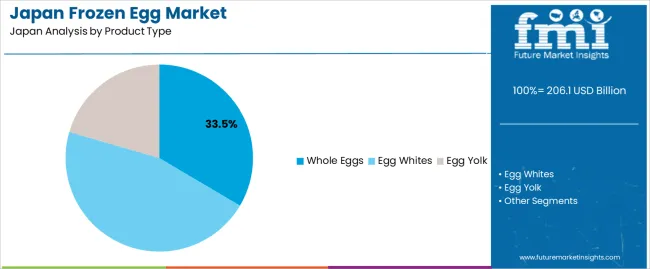
Egg whites lead the frozen egg market in Japan, accounting for 46% of the demand. Frozen egg whites are highly sought after for their versatility and functionality in food processing. They are particularly valued for their high protein content and their ability to improve the texture and consistency of a wide variety of products, from baked goods to sauces, dressings, and protein supplements. The demand for egg whites is driven by their use in the production of meringues, cakes, pastries, and whipped products, where their ability to create stable foams is essential.
The popularity of egg whites in Japan is also linked to the growing consumer preference for high-protein, low-fat foods. Frozen egg whites provide a convenient, cost-effective solution for food manufacturers looking to reduce waste while maintaining the quality of their products. As the demand for healthier food options continues to rise, the need for egg whites in processed foods, particularly in the bakery and confectionery industries, is expected to grow, ensuring their continued dominance in the frozen egg market.
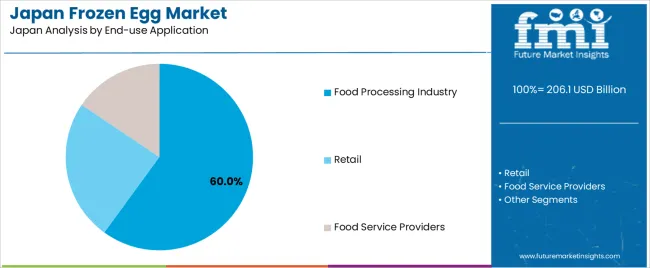
The food processing industry is the largest end-user of frozen egg products in Japan, accounting for 60% of the market share. Frozen eggs are crucial in the production of processed foods such as bakery items, snacks, ready-to-eat meals, sauces, and dressings. The food processing sector values frozen eggs for their long shelf life, ease of storage, and consistent quality, making them an ideal ingredient for large-scale production.
The demand from the food processing industry is driven by the need for standardized, high-quality ingredients that can be used across a wide range of products. As Japan's food industry continues to expand and diversify, particularly in packaged and convenience foods, the role of frozen eggs in maintaining the quality and consistency of food products becomes even more important. With the increasing popularity of ready-to-eat meals and processed snacks, the demand for frozen eggs in the food processing industry is expected to remain strong, securing its place as the leading application in Japan’s frozen egg market.
Demand for frozen egg products in Japan is driven by the nation’s advanced food-processing industry requirements for high-quality, stable egg ingredients. Japanese bakeries, confectioneries and ready-meal manufacturers require consistent functional properties that frozen egg products provide, leading to steady growth. At the same time, growth is moderated by the country’s limited population expansion and strong domestic fresh-egg culture, which constrains rapid volume increases in frozen formats.
Several drivers support growth in Japan. First, the food service and bakery sectors seek egg ingredients with extended shelf life, uniform quality and ease of use, which favour frozen egg whites, yolks and whole eggs. Second, high quality and food safety standards in Japanese manufacturing support adoption of pasteurised and frozen formats that reduce microbial risk. Third, growth in convenience foods, ready-meal production and industrial bakery lines drives need for standardised egg inputs. Fourth, imports of processed egg products, especially from the USA, reflect demand for specialty frozen formats to complement domestic egg supply.
Despite growth drivers, there are clear restraints. First, Japan’s strong preference for fresh-egg consumption, including raw or lightly cooked egg dishes, limits substitution with frozen formats. Second, high cost of frozen-egg processing, cold-chain logistics and ensuring product functionality to Japanese standards increases price relative to fresh eggs. Third, the modest growth of food-manufacturing categories where frozen egg inputs are used, versus fresh supply, restricts large-scale uptake. Fourth, the rigorous regulatory and hygiene standards in Japan raise barriers to entry for some frozen-egg suppliers.
Emerging trends include increasing use of frozen egg ingredients in premium confectionery and bakery applications, where precision and consistency are critical. Manufacturers are focusing on pasteurised frozen eggs imported or processed under strict quality-control systems to serve Japanese markets. There is a growing interest in value-added frozen egg forms, such as liquid pasteurised whole egg or pre-mixed blends, for convenience and industrial use. Additionally, importers are securing authorisations for frozen egg shipments from Thailand and other countries to meet demand in Japan.
The frozen egg market in Japan is experiencing steady growth driven by factors such as increased demand for convenience foods, growth in the foodservice and bakery sectors, and rising emphasis on food safety and shelf life extension. Frozen eggs provide manufacturers and foodservice operators with a consistent, easy to use substitute for fresh eggs, helping simplify processing and maintain quality.
As Japan’s population ages and labor costs rise, the shift to convenient and efficient ingredients like frozen eggs is accelerating. Regional growth reflects differences in food processing activity, population density, and distribution networks. Kyushu & Okinawa and Kanto lead in demand due to strong food manufacturing bases and logistics infrastructure, while Kinki, Chubu, Tohoku and the Rest of Japan show moderate to slower adoption. Below is a deeper regional breakdown.
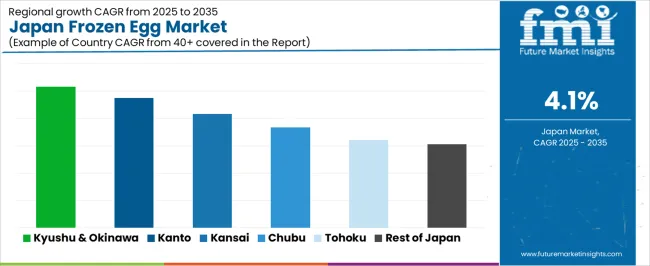
| Region | CAGR (2025-2035) |
|---|---|
| Kyushu & Okinawa | 5.2% |
| Kanto | 4.7% |
| Kinki | 4.2% |
| Chubu | 3.7% |
| Tohoku | 3.2% |
| Rest of Japan | 3.1% |
Kyushu & Okinawa leads the frozen egg market in Japan with a CAGR of 5.2%. The region’s strong agricultural sector, especially poultry farming and food processing, supports large scale use of frozen eggs. Many food manufacturing facilities utilize frozen egg products for baked goods, sauces, ready meals and other processed foods, which boosts regional demand. Logistics advantages, including port access for export and distribution, further support the adoption of frozen eggs by manufacturers in this area.
The region’s move toward convenience foods and increased foodservice operations especially in tourism driven Okinawa also drives growth in frozen egg usage. As labor becomes more expensive and manufacturers look for solutions to optimize processing, frozen eggs are an attractive ingredient due to their ease of handling and storage stability. These factors help explain the higher growth rate in Kyushu & Okinawa compared to other regions.
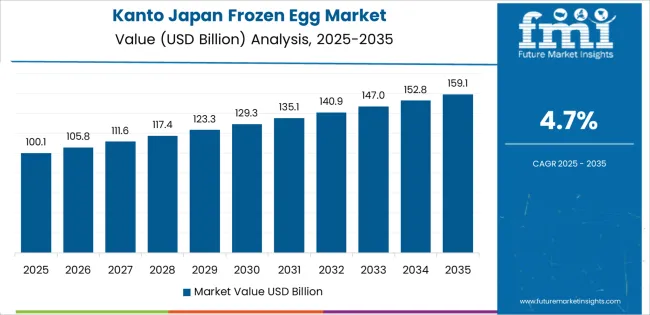
The Kanto region, which includes Tokyo and its surrounding prefectures, reports a CAGR of 4.7%. As Japan’s most populous and economically active region, Kanto has strong demand from foodservice, bakeries, convenience stores and ready meal producers all of whom rely on efficient ingredients like frozen eggs. The large urban population and fast paced lifestyle in Kanto increase consumption of convenience and processed foods, boosting frozen egg uptake.
Also, Kanto has robust cold chain infrastructure, enabling effective handling and distribution of frozen egg products across retail and foodservice channels. The region’s focus on quality, standardization and food safety aligns well with the benefits provided by frozen egg systems, helping to sustain demand in this region.
The Kinki region demonstrates a CAGR of 4.2%. Kinki, which includes Osaka and Kyoto, has a strong food manufacturing and bakery sector, with a wide range of products requiring egg ingredients. Frozen eggs offer consistency, cost savings and storage benefits, leading many manufacturers in Kinki to adopt them.
While Kinki’s growth is somewhat lower than the leading regions, its mature manufacturing base and focus on food processing innovations including production of packaged baked goods and ready to eat meals create reliable demand for frozen eggs. The region’s proximity to large consumer markets also helps distribution and adoption of frozen egg products.
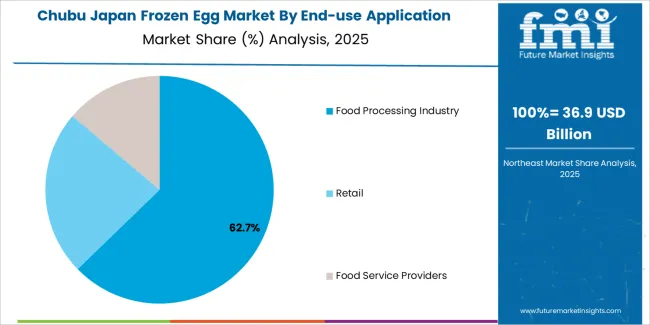
The Chubu region, with a CAGR of 3.7%, includes industrial and manufacturing hubs such as Nagoya. The food processing sector here is sizable, and frozen eggs are used in baked goods, sauces, bakery mixes and foodservice operations. Though growth is more moderate compared to coastal regions, Chubu benefits from its manufacturing efficiency and logistics networks.
Also, the region’s focus on cost reduction and optimization of supply chains aligns with the advantages of frozen eggs especially for food manufacturers seeking to minimize waste and enhance productivity. As these trends continue, demand in Chubu will maintain steady growth.
Tohoku shows a CAGR of 3.2% and the Rest of Japan 3.1%. These regions are more rural and less densely populated than major urban centers, which affects the speed of adoption of frozen egg technologies. Their food service and manufacturing sectors tend to be smaller or more traditional, and large scale cold chain infrastructure may be less developed.
However, even in these regions the demand for frozen eggs is rising, driven by increasing interest in convenience foods, processed food manufacturing, and improvements in distribution logistics. As regional food manufacturing firms look to improve efficiency and reduce dependence on fresh eggs, their adoption of frozen eggs will continue to grow albeit at a slower rate.
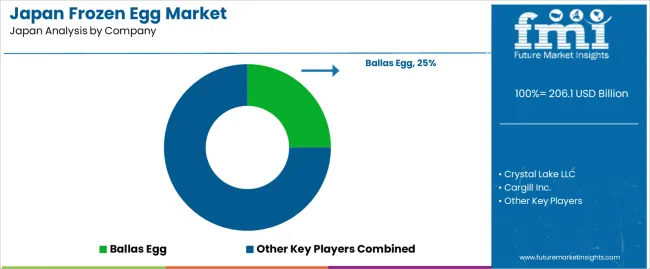
Demand for frozen egg products in Japan is increasing, driven by the growing need for convenient, cost-effective, and long shelf-life solutions in food manufacturing, restaurants, and the foodservice industry. Companies like Ballas Egg (holding approximately 25% market share), Crystal Lake LLC, Cargill Inc., Pace Farm, and Sonstegard Foods are key players in this industry. The rise in consumer demand for processed and ready-to-use egg products, as well as the growing trend of convenience in food preparation, is fueling the expansion of the frozen egg market in Japan. Additionally, the food processing sector is looking for stable, quality ingredients that can be stored long-term, which makes frozen eggs a practical solution.
Competition in the frozen egg industry is driven by product quality, price competitiveness, and the ability to meet the specific demands of the food industry. Companies focus on offering high-quality frozen egg products, such as whole eggs, egg whites, and yolks, that retain their nutritional value and performance in cooking applications. Another competitive factor is packaging and storage efficiency, as manufacturers work to ensure products can be stored and transported with minimal waste.
Some companies are also focusing on innovations like egg alternatives or specialized formulations for certain food applications. Marketing materials typically highlight features such as product consistency, long shelf life, nutritional integrity, and suitability for various food production needs. By aligning their products with the growing demand for convenience, cost-effectiveness, and quality in food preparation, these companies aim to strengthen their position in the Japanese frozen egg industry.
Kewpie Corporation
NH Foods Ltd.
Akita Foods Co., Ltd.
Ise Foods Inc.
Morinaga Milk Industry Co., Ltd.
Taiyo Kagaku Co., Ltd.
Cargill Inc.
| Items | Details |
|---|---|
| Quantitative Units | USD Billion |
| Regions Covered | Japan |
| Product Type | Whole Eggs, Egg Whites, Egg Yolk |
| End-use Application | Food Processing Industry, Retail, Food Service Providers |
| Key Companies Profiled | Kewpie Corporation, NH Foods Ltd., Akita Foods Co., Ltd., Ise Foods Inc., Morinaga Milk Industry Co., Ltd., Taiyo Kagaku Co., Ltd., Cargill Inc. |
| Additional Attributes | The market analysis includes dollar sales by product type and end-use application categories. It also covers regional demand trends in Japan, particularly driven by the food processing industry and retail sectors. The competitive landscape highlights key suppliers focusing on frozen egg products and innovations in egg processing. Trends in the increasing demand for frozen egg whites and whole eggs for food production and service applications are explored, along with advancements in packaging, logistics, and shelf-life optimization. |
The global demand for frozen egg in Japan is estimated to be valued at USD 206.1 billion in 2025.
The demand for frozen eggs in Japan is projected to reach USD 308.8 billion by 2035.
The demand for frozen egg in Japan is expected to grow at a 4.1% CAGR between 2025 and 2035.
The key product types are whole eggs, egg whites and egg yolk.
In terms of end-use application, the food processing industry segment is expected to command 60.0% share in the demand for frozen egg in Japan in 2025.






Our Research Products

The "Full Research Suite" delivers actionable market intel, deep dives on markets or technologies, so clients act faster, cut risk, and unlock growth.

The Leaderboard benchmarks and ranks top vendors, classifying them as Established Leaders, Leading Challengers, or Disruptors & Challengers.

Locates where complements amplify value and substitutes erode it, forecasting net impact by horizon

We deliver granular, decision-grade intel: market sizing, 5-year forecasts, pricing, adoption, usage, revenue, and operational KPIs—plus competitor tracking, regulation, and value chains—across 60 countries broadly.

Spot the shifts before they hit your P&L. We track inflection points, adoption curves, pricing moves, and ecosystem plays to show where demand is heading, why it is changing, and what to do next across high-growth markets and disruptive tech

Real-time reads of user behavior. We track shifting priorities, perceptions of today’s and next-gen services, and provider experience, then pace how fast tech moves from trial to adoption, blending buyer, consumer, and channel inputs with social signals (#WhySwitch, #UX).

Partner with our analyst team to build a custom report designed around your business priorities. From analysing market trends to assessing competitors or crafting bespoke datasets, we tailor insights to your needs.
Supplier Intelligence
Discovery & Profiling
Capacity & Footprint
Performance & Risk
Compliance & Governance
Commercial Readiness
Who Supplies Whom
Scorecards & Shortlists
Playbooks & Docs
Category Intelligence
Definition & Scope
Demand & Use Cases
Cost Drivers
Market Structure
Supply Chain Map
Trade & Policy
Operating Norms
Deliverables
Buyer Intelligence
Account Basics
Spend & Scope
Procurement Model
Vendor Requirements
Terms & Policies
Entry Strategy
Pain Points & Triggers
Outputs
Pricing Analysis
Benchmarks
Trends
Should-Cost
Indexation
Landed Cost
Commercial Terms
Deliverables
Brand Analysis
Positioning & Value Prop
Share & Presence
Customer Evidence
Go-to-Market
Digital & Reputation
Compliance & Trust
KPIs & Gaps
Outputs
Full Research Suite comprises of:
Market outlook & trends analysis
Interviews & case studies
Strategic recommendations
Vendor profiles & capabilities analysis
5-year forecasts
8 regions and 60+ country-level data splits
Market segment data splits
12 months of continuous data updates
DELIVERED AS:
PDF EXCEL ONLINE
Demand Signal Repository Solutions Market Size and Share Forecast Outlook 2025 to 2035
Demand Side Management Market Size and Share Forecast Outlook 2025 to 2035
Demand Response Market Analysis - Size, Share, and Forecast Outlook 2025 to 2035
North America Shipping Supplies Market Trends – Innovations & Growth 2024-2034
Demand of Kozani Saffron in Greece Analysis - Size, Share & Forecast 2025 to 2035
Demand of No-acid Whey Strained Dairy Processing Concepts in European Union Size and Share Forecast Outlook 2025 to 2035
Demand for Bronte Pistachio in Italy Analysis - Size, Share & Forecast 2025 to 2035
Demand and Trend Analysis of Gaming Monitor in Western Europe Size and Share Forecast Outlook 2025 to 2035
Demand and Trend Analysis of Gaming Monitor in Korea Size and Share Forecast Outlook 2025 to 2035
Demand and Trend Analysis of Gaming Monitor in Japan Size and Share Forecast Outlook 2025 to 2035
Glycine Soja (Soybean) Seed Extract Market Size and Share Forecast Outlook 2025 to 2035
Demand and Trend Analysis of Yeast in Japan - Size, Share, and Forecast Outlook 2025 to 2035
Demand of Pistachio-based desserts & ingredients in France Analysis - Size, Share & Forecast 2025 to 2035
Western Europe Men’s Skincare Market Analysis – Forecast 2023-2033
Demand and Trends Analysis of Stevia in Japan Size and Share Forecast Outlook 2025 to 2035
Japan Women’s Intimate Care Market Trends – Growth & Forecast 2024-2034
Demand and Trend Analysis of Fabric Stain Remover in Korea Size and Share Forecast Outlook 2025 to 2035
Demand and Sales Analysis of Paper Cup in Korea Size and Share Forecast Outlook 2025 to 2035
Demand and Sales Analysis of Paper Cup in Western Europe Size and Share Forecast Outlook 2025 to 2035
Demand of MFGM-enriched Powders & RTDs in European Union Size and Share Forecast Outlook 2025 to 2035

Thank you!
You will receive an email from our Business Development Manager. Please be sure to check your SPAM/JUNK folder too.
Chat With
MaRIA